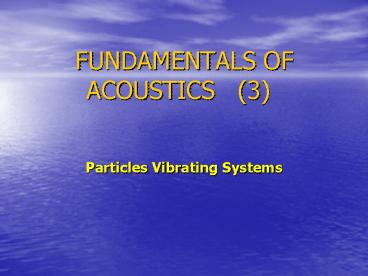FUNDAMENTALS OF ACOUSTICS 3 - PowerPoint PPT Presentation
1 / 34
Title:
FUNDAMENTALS OF ACOUSTICS 3
Description:
Whenever a real body is set into oscillation, dissipative (frictional)forces ... As with the undamped oscillator,the frequency is independent of the amplitude of ... – PowerPoint PPT presentation
Number of Views:309
Avg rating:3.0/5.0
Title: FUNDAMENTALS OF ACOUSTICS 3
1
FUNDAMENTALS OF ACOUSTICS (3)
- Particles Vibrating Systems
2
REVIEW Simple harmonic motion
3
(No Transcript)
4
(No Transcript)
5
(No Transcript)
6
1-2 DAMPED OSCILLATIONS
- Whenever a real body is set into oscillation,
dissipative (frictional)forces arise.These forces
are of many types, depending on the particular
oscillating system.but they will always result
in a damping of the oscillations- a decrease in
the amplitude of the free oscillations with time.
7
Let us first consider the effect of a viscous
frictional force
On a simple oscillator
- Such a force is assumed to be proportional to
the speed of the mass and to be directed so as to
oppose the motion. It can be expressed as
Where Rm is a positive constant called the
mechanical resistance of the system.
8
- It is evident that mechanical resistance has the
units of nweton-second per meter (N.s/m) - If the effect of resistance is included ,the
equation of motion of an oscillator becomes
9
- Dividing through by m and recalling that
We have
10
- This equation may be solved by the complex
exponential method.Assume a solution of the form
µ1?µ2
Are two solutions of follow equation
11
We can obtain
1. When
,Rm24mD
If the mechanical resistance Rm is large enough,
the system is no longer oscillatory
12
- In most cases of importance in acoustics ,the
mechanical resistance Rm is small enough so that
,µ
lt
is complex. Now , µis given by
13
Defining a new constant Oby
- Now µ is given by
- And Ois seen to be the natural angular frequency
of the damped oscillator. - Notice that Ois always less than the natural
angular frequency ?0 of the same oscillator
without damping.
14
The complete solution is the sum of the two
solutions obtained above,
- One convenient form of this general solution is
Where A and fare real constants determined by the
initial conditions.
15
The amplitude of the damped oscillator, now
defined as
A(t) is on longer constant, but decreases
exponentially with time. As with the undamped
oscillator,the frequency is independent of the
amplitude of oscillation.
16
- One measure of the rapidity with which the
oscillations are damped by friction is the time
required for the amplitude to decrease to 1/e of
its initial value.This time is called decay
modulus and is given by
The quantity d is called the resistance
coefficient .
17
Fig.displays the time history of the displacement
of a damped harmonic oscillator
X(t)
18
ENERGY OF VIBRATION
19
1.3 FORCED OSCILLATIONS
- 1 . A simple oscillator, when driven by an
externally applied force F, the differential
equation for the motion becomes
20
If FFmcos?t, and it will be advantageous to
replace the real driving force Fmcos?t by its
equivalent complex driving force fF exp(j?t
)we can write in the form
?? ?0
21
Initial conditions
For A?0,f0 0
22
This special pattern of motion is known as the
beating phenomenon. Sound waves of slightly
different frequencies will also give rise to
beats .
23
2.In a damping of the oscillations,the
differential equation for the motion becomes
(1-3)
24
- O?0
When
Assume a solution of the form
And substitute into equation to obtain
25
We obtain
26
Zm is called the complex mechanical impedance ,Rm
is called the mechanical resistance Xm is
called the mechanical reactance
The mechanical impedance
Has magnitude
And phase angle
27
- The dimensions of mechanical impedance are the
same as those of mechanical resistance and are
expressed in the same units, N.s/m, often defined
as mechanical ohms. - It is to be emphasized that , although the
mechanical ohm is analogous to the electrical
ohm, these two quantities do not have the same
units. - The electrical ohm has the dimensions of voltage
divided by current - The mechanical ohm has the dimensions of force
divided by speed.
28
The solution of equation is The sum of two parts
a transient term a
steady-state term
29
For the case of a sinusoidal driving force
f(t)Fmcos(?t) applied to the oscillator at some
initial time, the solution of (1-3) is the sum of
two parts a transient term containing two
arbitrary constants and a steady-state term which
depends of F and ? but does not contain any
arbitrary constants. The transient term is
obtained by setting F equal to zero. The
arbitrary constants are determined by applying
the initial conditions to the total solution.
30
After a sufficient time interval, The damping
term makes this portion of the solution
negligible. Leaving only the steady state term
whose angular frequency ? is that of the driving
force
31
ENERGY OF VIBRATION
32
(No Transcript)
33
Problems-Waves
- 1-2 Prove each wave addition
34
Problem Simple Harmonic Motions
- 1-3 A simple harmonic motion is given as
x(t)10sin(10t-300), where x is measured in
meters , t in seconds , and the phase angle in
degrees. Find (1) the frequency and period of the
motion, (2) the maximum displacement ,velocity
and acceleration, (3) the displacement ,
velocity and acceleration at t0 and t1 seconds.


















![[PDF] Fundamentals of Phonetics: A Practical Guide for Students 6th Edition Ipad PowerPoint PPT Presentation](https://s3.amazonaws.com/images.powershow.com/10077867.th0.jpg?_=20240712086)












